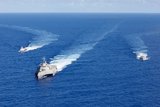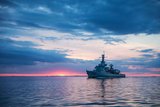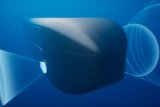Raytheon's Total Ship Computing Environment passes critical review
Raytheon Company's open architecture Total Ship Computing Environment (TSCE), the integrated mission system for the DDG 1000 Zumwalt-class destroyer, recently passed a key Technology Readiness Assessment.
The TRA, conducted by the US Navy, confirmed that TSCE is now at Technology Readiness Level 6 as a result of the system's ability to operate in a relevant end-to-end environment. The review revealed a high pass rate for system requirements as well as low software defect counts.
"In developing more than six million lines of code, TSCE is one of the most complex software projects ever undertaken," said Raytheon Integrated Defense Systems' (IDS) Bill Marcley, vice president of Total Ship Mission Systems. "With each successful software milestone, we are mitigating risk and enhancing the reliability of this highly capable open architecture system."
Members of the Navy's TRA panel commended the robustness of Raytheon's simulation environment and the company's thorough approach to integration and testing. From design to production, Raytheon has partnered with the Navy to develop a thorough testing process to mitigate any potential risks involved with integrating the mission system software with the ship's hardware.
Raytheon's TSCE encompasses all shipboard computing applications, including the combat management system; command, control, communications, computers, and intelligence elements; ship machinery control systems; damage control; embedded training; and support systems. The system leverages a modern open system architecture that provides a scalable platform for cost-efficient delivery of new mission capability.
TSCE delivers an unprecedented level of modularity and automation, helping to advance the Navy's open architecture goals. The sailor-centric, human-computer interface, combined with the high level of automation achieved with TSCE, is a primary driver for the significant reduction in manning for the DDG 1000 Zumwalt-class destroyer when compared with today's Arleigh Burke-class destroyers.
Raytheon performs software work for the DDG 1000 program at IDS Headquarters, Tewksbury, Mass.; at the Seapower Capability Center, Portsmouth, R.I.; at the Surveillance and Sensors Center, Sudbury, Mass.; at the Expeditionary Warfare Center, San Diego, Calif.; and at several other Raytheon facilities.
Source: Raytheon
More from Digital Battlespace
-
![Babcock nears first customer for Nomad AI translation tool]()
Babcock nears first customer for Nomad AI translation tool
Nomad can provide militaries with real-time intelligence, saving critical time on the battlefield.
-
![AUSA 2025: Israel’s Asio Technologies to supply hundreds of improved Taurus tactical systems]()
AUSA 2025: Israel’s Asio Technologies to supply hundreds of improved Taurus tactical systems
Taurus operates alongside the Israel Defense Forces’ Orion system which supports mission management across tens of thousands of manoeuvring forces, from squad leaders to battalion commanders.
-
![AUSA 2025: Kopin pushes micro-LED plans as China moves faster]()
AUSA 2025: Kopin pushes micro-LED plans as China moves faster
The plan for the new displays follows fresh investment in Kopin’s European facilities by Theon and an order for head-up displays in fielded aircraft, with funding from the US Department of Defense.
-
![AUSA 2025: Persistent Systems to complete its largest order by year’s end]()
AUSA 2025: Persistent Systems to complete its largest order by year’s end
Persistent Systems received its largest ever single order for its MPU5 devices and other systems earlier this month and has already delivered the 50 units to the US Army’s 4th Infantry Division.
-
![Aselsan brings in dozens of companies and systems under the Steel Dome umbrella]()
Aselsan brings in dozens of companies and systems under the Steel Dome umbrella
Turkey has joined the family of countries attempting to establish a multilayered air defence system with government approval in August 2024 for the effort landed by Aselsan. Dubbed Steel Dome, the programme joins Israel’s Iron Dome, the US Golden Dome, India’s Mission Sudarshan Chakra and South Korea’s low-altitude missile defence system.
-
![DSEI 2025: MARSS unveils new agnostic multidomain C4 system]()
DSEI 2025: MARSS unveils new agnostic multidomain C4 system
MARSS’ NiDAR system has been deployed using sensors from static platforms to provide detection and protection for static sights, such as critical infrastructure, ports and military bases.




























